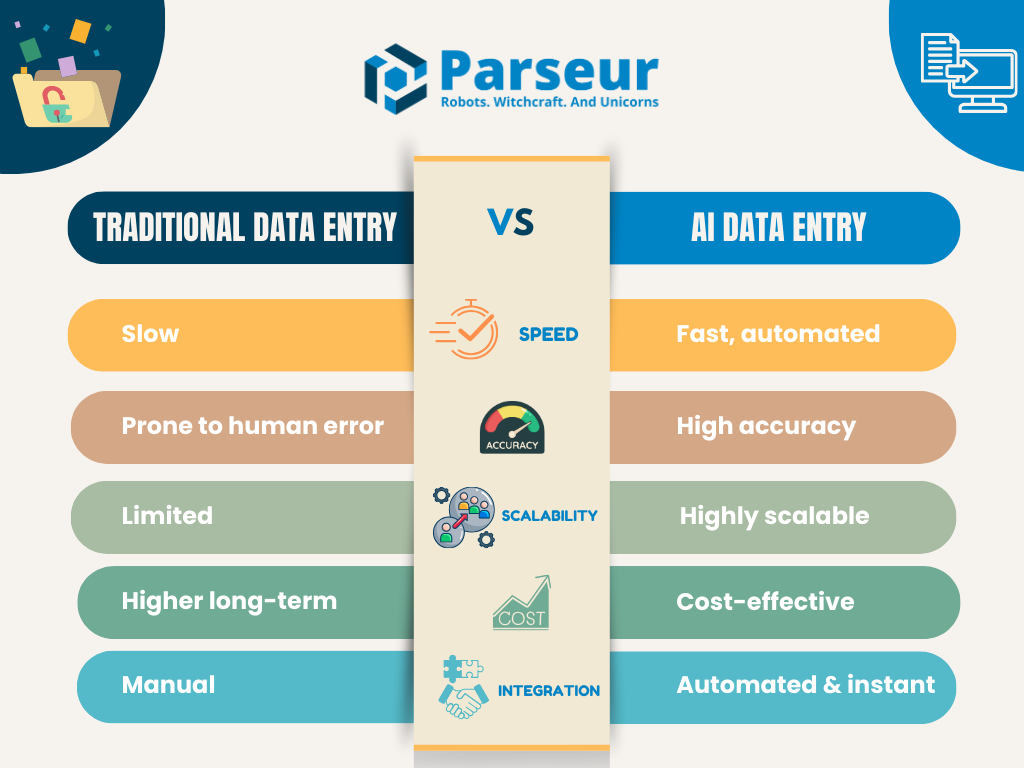Data entry is the backbone of many businesses, but let's be honest: it's rarely anyone's favorite task. Getting that data into your system is essential whether you're dealing with customer information, financial records, or anything else. But with the rise of AI, many are left wondering, ‘Should we stick with the old ways or make the leap to automation?’
This isn't just a technical question; it's about efficiency, accuracy, and your bottom line. What kind of workflow are you looking for?
The choice between traditional approaches and advanced technology isn't always straightforward. Both have their place in modern business operations, but understanding the key differences can help you make informed decisions that align with your specific needs.
Are you tired of spending countless hours and resources on repetitive, error-prone data entry tasks? You're not alone. Many businesses face a common dilemma: continue with traditional manual data entry or adopt AI-driven automation to enhance efficiency and accuracy. This article explores the critical differences between AI and traditional data entry software, helping you decide which solution best fits your business.
What is traditional data entry?
Traditional data entry, often called manual data entry,is inputting information into a system by hand. It's still widely practiced due to familiarity and simplicity.
- Standard tools: Microsoft Excel, Google Sheets, Typeform
- Typical applications: Small-scale tasks, simple record-keeping
Common use cases for traditional data entry
- Retail & E-commerce: Managing product catalogs, pricing, and inventory.
- Healthcare: Inputting patient records and insurance details.
- Finance & Accounting: Entering invoices, transactions, and payroll details.
- Human Resources: Processing job applications and employee data.
Despite technological advances, traditional data entry remains prevalent across numerous industries. Healthcare facilities often rely on manual entry for patient records, financial institutions process paperwork this way, and retail businesses frequently use it for inventory management. Small to medium-sized enterprises with limited technology budgets depend on these conventional methods.
Limitations of traditional data entry
While traditional data entry methods have faithfully served businesses for decades, they have inherent drawbacks that become increasingly problematic as organizations scale and data volumes grow.
The human factor, while providing flexibility, introduces inconsistency and error. Research by Gartner reveals that poor data quality costs organizations an average of $12.9 million annually. Even the most diligent professionals make mistakes when performing repetitive data entry tasks over extended periods. (Gartner)
Speed limitations represent another significant challenge. As data volumes increase, organizations often face difficult choices: hire additional staff, accept processing delays or risk quality issues from overworked employees.
Scalability presents the most formidable barrier. This increased need for human resources can lead to higher labor costs and potential inefficiencies. In contrast, automation enables businesses to handle larger workloads more efficiently, reducing the reliance on additional staff and minimizing the risk of errors associated with manual data entry.
The cost implications extend beyond direct labor expenses. For instance, the average hourly pay for data entry positions in the United States is approximately $19.47, with wages ranging from $11.06 to $28.37 per hour. This figure reflects direct labor costs but does not account for additional expenses such as benefits, workspace, and related overhead. (ZipRecruiter)
Finally, traditional methods struggle with integration across modern tech stacks. Manual processes create information silos and bottlenecks, with data trapped in spreadsheets or isolated databases rather than flowing seamlessly between systems.
This widespread reliance on manual processes explains why businesses increasingly seek more efficient alternatives to reduce this significant time investment while maintaining accuracy.
What is AI data entry automation?
Automated data handling represents the evolution of data processing, using artificial intelligence and machine learning technologies to handle information capture, extraction, and management with minimal human intervention.
AI-driven data entry automation eliminates the need for manual input by leveraging technologies such as
- Optical character recognition (OCR): Extracts text from scanned documents and images.
- Machine learning algorithms: Learns from past data to improve accuracy over time.
- Automated data extraction: Identifies, categorizes, and inputs data into relevant fields.
- Computer vision systems: Process visual data from documents and images.
- Intelligent document processing: Combines these technologies to handle complex document formats.
Growth in AI adoption
AI-powered systems' ability to understand context, not just capture text, sets them apart. When processing an invoice, for example, these systems don't just read the document—they comprehend what constitutes a date, amount, invoice number, and vendor information without explicit programming for each format variation.
The Intelligent Document Processing (IDP) reports project the intelligent document processing market to grow significantly, reaching $66.68 billion by 2032 at a CAGR of 30.1% during the forecast period. This aligns with the transformative potential of IDP technologies. This rapid expansion reflects the growing recognition of these technologies' transformative potential. (Fortune Business Insights)
Organizations increasingly recognize that these technologies can transform what was once a necessary cost center into a strategic advantage.
One notable AI-powered tool is Parseur, which automates data extraction from emails, PDFs, and invoices, significantly reducing processing time.
Benefits of AI data entry automation
The transition from manual to AI-powered data entry offers transformative advantages beyond simple time savings. Organizations implementing these technologies report substantial improvements across multiple performance dimensions.
1. Improved accuracy
Accuracy improvements represent one of the most significant benefits. AI-powered data capture solutions achieve accuracy rates exceeding the average for traditional methods. This difference may seem subtle until you consider that it translates to fewer errors in practice. This improvement can prevent costly mistakes and compliance issues for financial institutions processing thousands of transactions daily.
2. Increased efficiency & speed
Automated data entry systems significantly outpace manual methods, reducing the time required to process large volumes of information. Organizations that have adopted AI-driven document processing report substantial improvements in workflow efficiency. For example, companies in insurance and finance have enhanced operations, cutting down processing times from days to just a few hours. This acceleration boosts productivity and enhances customer satisfaction by ensuring faster turnaround times.
3. Reduced operational costs
Cost efficiency is a significant advantage of AI-driven data entry. Organizations that adopt automation often experience significant reductions in operational expenses. These savings come from reduced labor costs and fewer errors, minimizing the need for costly corrections and rework. In healthcare, finance, and logistics industries, companies have reported substantial financial benefits after automating data-intensive processes, leading to better resource allocation and improved efficiency.
4. Scalability & adaptability
Automated data entry solutions offer unmatched scalability, allowing businesses to process growing volumes of information without a proportional increase in costs or workforce. Unlike manual methods, where expansion requires hiring more staff and increasing overhead, AI-driven systems can handle surges in data with minimal additional resources. This flexibility primarily benefits companies experiencing seasonal spikes or rapid growth, ensuring efficiency without operational bottlenecks.
Integration capabilities represent an often-overlooked advantage. Modern data automation tools typically offer strong API connections and pre-built integrations with popular business systems. This interoperability eliminates data silos and enables information to flow seamlessly between applications—creating connected ecosystems instead of isolated data repositories.
Perhaps most importantly, these systems free human talent for higher-value work. Workers who use generative AI tools can boost their performance by up to 40% compared to those who do not. This reallocation of human resources allows businesses to maximize their most valuable asset—the creative and analytical capabilities of their people. (The Business Dive)
AI vs. Traditional data entry: Side-by-side comparison
Comparing key performance factors can clarify the decision when evaluating which approach best suits your organization's needs. The following comparison examines how AI and traditional methods stack up across critical operational dimensions.

How do you choose the correct data entry method?
Choosing between traditional and AI-powered data entry depends mainly on your business context and requirements. Understanding the scenarios where each approach shines can guide your decision-making process.
When traditional data entry works best
- Small businesses handling limited data.
- Situations requiring human validation (e.g., sensitive legal documents).
- Organizations with tight budgets that can’t invest in AI tools yet.
When to upgrade to AI data entry
- Businesses managing large volumes of repetitive data.
- Companies looking to scale operations without increasing labor costs.
- Industries where accuracy and speed are critical (e.g., finance, healthcare, logistics).
Many organizations ultimately adopt hybrid approaches. A typical implementation strategy involves using AI for initial data capture and extraction from standard documents while employing human review for validation and handling exceptions. This approach combines the speed and efficiency of automation with human judgment for quality assurance.
Conclusion
Traditional methods still have their place—particularly for low-volume, highly variable, or specialized processing needs but the balance is shifting decidedly toward intelligent automation.
As you evaluate your data entry needs, consider starting with a focused assessment of your current processes. Identify where manual bottlenecks create the most significant operational friction and explore how intelligent automation might address these pain points. Remember that successful implementation typically involves thoughtful change management, bringing your team members into the conversation early, and focusing on how automation can enhance rather than threaten their roles.
Frequently Asked Questions
Several common questions and misconceptions often arise when considering transitioning from traditional to AI-powered data entry. Addressing these concerns can help organizations make more informed decisions.
-
Is advanced data automation expensive?
-
While initial investment costs may seem high, businesses save significantly in the long run through improved efficiency and reduced labor costs.
-
Do we have to abandon Excel for AI automation?
-
Not necessarily! Many AI tools integrate with Excel and Google Sheets, automating data entry while maintaining familiar workflows.
-
Will AI eliminate jobs in our organization?
-
Not necessarily. AI reduces repetitive work, allowing employees to focus on higher-value tasks like analysis and decision-making instead of manual data entry.
-
How accurate are automated data handling systems compared to human operators?
-
AI-powered tools can achieve 99%+ accuracy, depending on the quality of the data and AI training. This is significantly higher than manual data entry, which is prone to human errors.
Last updated on




